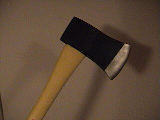Though native[s]… like me are gradually being outnumbered by newcomers, we remain tied to the land in a way outsiders will never understand… Without it, we lose our cultural identity and, ultimately, ourselves. This is not a new fight; it has raged in these mountains for generations as our land has been exploited again and again.
 This is not a quote from Chief Sealth. It is from a letter in Newsweek lamenting the development of rural Appalachia.
This is not a quote from Chief Sealth. It is from a letter in Newsweek lamenting the development of rural Appalachia.
I empathize with the author’s plight, but not his myopic perspective. His great, great, great grandpappy took that land from Native Americans (who undoubtedly took it from someone else). We are all the same, we human beings. Our history is one long power struggle. I can’t see how the future will look any different. He is on the losing end of the power struggle this time.This article meshed nicely with another one from Orion Magazine (via The Uneasy Chair). This is not a new argument. Should indigenous people remain inside nature preserves? The answer is yes, if they can continue to live in equilibrium inside that preserve. If they cannot, things get a lot more complicated.
Note in the above Orion article the staged photo of the obese, elderly gentlemen in the Nike gym shorts holding authentic aborigine artifacts. The myth of the noble savage* is a tenacious one. Obesity and old age don’t usually go hand in hand with Stone Age cultures. Introduced technology is the real kiss of death for any remaining Stone Age culture (things like steel axes, firearms, and domesticated farm animals).
Following are two telling remarks from the same article, from people in two transitioning cultures. One is from a hunter/gatherer culture and the other is from a culture that has already transitioned into pastoral farming:
Our own guns were confiscated … no more hunting, no more trapping, no more snaring, and no more “slash and burn.”
Hunting we can live without, as we raise chickens, pigs, and buffalo. But rotational farming is our way of life.
To live in equilibrium within your natural environment, you must have a stable population/natural-resource ratio. If your population grows (thanks to reduced childhood mortality resulting from introduced technology like firearms or domesticated animals providing more protein), the area containing your natural resources must grow also. It can’t, so you will either destroy it or use new technology to squeeze more out of it. Either way, the old way of life is over.
In the old days, another option was to attack the adjoining culture and take their resources. This is human history in a nutshell. Technology, by the way, is not the only thing changing Stone Age cultures.
If indigenous populations could not obtain metal cooking pots, steel axes, and firearms, their populations would not grow, but they will all eventually have those things, because they want them. The demise of their old ways is a done deal. It is only a matter of time before this new technology causes them to outstrip their resources.
Given that cultures are never static and have always been subject to periods of rapid change when in close contact with another culture, should we cling to the pipe dream that we can halt these particular transitions? Look at the effect American television is having on cultures all over the planet. Or should we find better ways to help them make the transition? Hopefully something a little more imaginative than massacres, reservations, welfare, and casinos. And maybe this time, instead of replacing their forests with strip malls, we will be successful in preserving them — ideally with their participation.
* The Aztecs sacrificed about a quarter of a million people a year by ripping out their still-beating hearts. What did they do with all the bodies, you might ask? Well, they ate them. The Mayans and Incas were also big on sacrifices, especially of children. And let us not leave out the Chimú, Huari, Moche, Nazca, and Chavín peoples as well.
 This is not a quote from Chief Sealth. It is from a letter in
This is not a quote from Chief Sealth. It is from a letter in 

